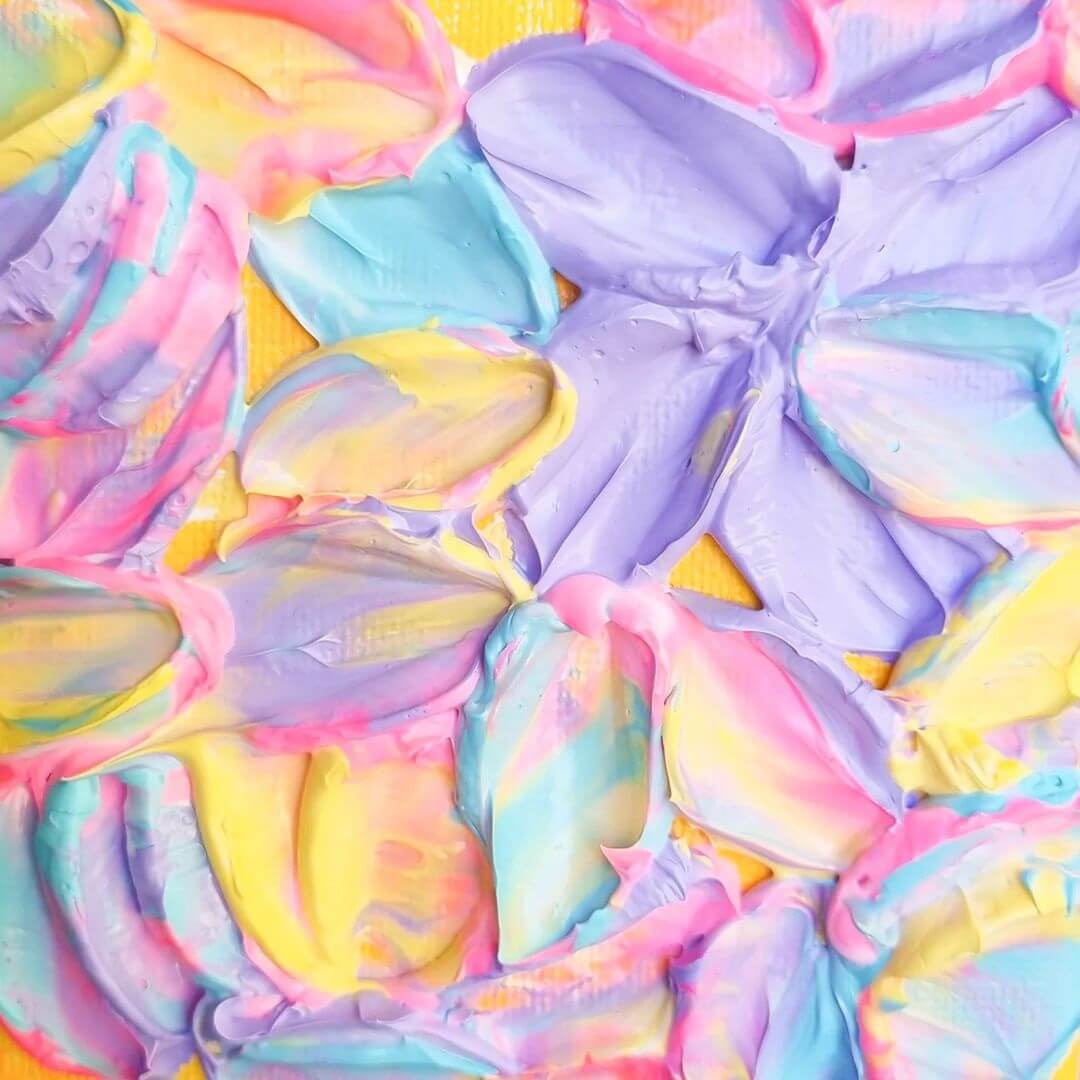1. Pastel meets impasto

Believe it or not, mixing in impasto with your acrylic paints is enough to create dreamy texture like this! Impasto is worth dipping into next time you’re looking for something new, it’s easy to use and it’s a great way to add texture and thickness to your paints. Then play around with your paint colours to create fun loving pastel tones. This texture idea was created using our impasto!
2. Palette knife painting

This acrylic paint texture idea is great for those moments where you feel like creating but don’t have many clean brushes on hand. Reach for a palette knife and try your hand at creating some texture like this. Add impasto to your paints for thicker texture or reach for our dimension acrylic, then scoop up the paint with a palette knife, before applying it directly to the canvas.
3. Play with shapes

We love this idea of playing around with shapes to add texture. If you’re looking for a new medium to try, take a look at modelling paste and experiment with creating shapes with paste. You can mix modelling paste with acrylic paints if you’re looking for thicker paint. Or you can have a go at shapes using paste and then paint over the top. Dial up the fun with waves, swirls, circles, squares and splotches, but most importantly have fun! You might get it right the first time or you might not, either way you can still create something awesome.
4. Block in colours

Looking for something fun to try? Mix in a bit of impasto with your acrylic paints, then try blocking your colours in using a palette knife. For landscapes, lightly draw where you’d like your colours to go before picking up the paints, then block your colours in by working darkest to lightest. For more on this texture technique, check out our article here and we’ll show you how it’s done.
5. Limited colour palette

Challenge yourself and your texture creations, by limiting your palette to get your creative juices flowing. This textured idea is made up of just three colours and it just goes to show that you don’t need a massive collection of paint to get started. So, what are you waiting for? Grab some impasto, a few paint colours and get creating!
6. Terracotta arches

How satisfying are these?! You can create your own arches by using modelling paste! Apply a layer of modelling paste over your artwork, then smooth it out. Pop your shapes in using a palette knife and add directional lines to create arch shapes. Once it’s dry, it’s ready for you to grab the paint brushes.
7. Accentuate areas

Don’t be afraid to paint over your texture once it’s dry, to accentuate areas. We’ve used impasto and acrylic in this idea, then reached for a smaller brush to add in a bit of fun and mark out the areas. Try this idea for yourself with our video tutorial.
8. Crackle paste
Image:darlene_goodman
Crackle paste is a great medium to try for creating new and exciting textures! It not only helps add interest, but it can also make your artworks look weathered which is great for landscapes.Crackle paste dries to an opaque, white finish, so it can change the colour of your paints, meaning pastel colours just got easier!
Apply your colour first, then add a thin, even application of paste over the top, wait for it to dry and then enjoy your new texture. For more on crackle paste check out our 11 common crackle paste questions.
9. Use texture as a focal point

If you’re wanting to create a landscape or a beach scene but still looking for some texture, try using modelling paste as your focal point. We love this idea of using a heavy texture for the wave, adding smaller waves in too, plus the circular canvas is really the icing on the cake.
10. Dreamy blends

These dreamy blends of blue, pink, purple and gold look extra special with texture added.
You don’t need a whole lot to have fun with texture, you can add texture to your acrylic paintings using household items. For a fine texture, try sprinkling sand onto the canvas or mixing it directly into your paints, this will thicken the paint and give you a thicker, grainy texture. It’s worth a try! For more on using household items to add texture, check out our how to video.
11. Play with gradients

We love this idea of playing with gradients. Next time you’re dipping into impasto, try a blend of colour and apply your darkest colour at the top or bottom, then your lightest colour and use a palette knife to blend. Or build up the texture then apply the gradient colours over the top.
12. Try mixed media

Add even more texture to your acrylic artworks and take a mixed media approach. Fabrics like lace, hessian, string, rope or buttons can add interesting effects to your artworks. Glue the material on first, then cover it up with your acrylic paint!






























